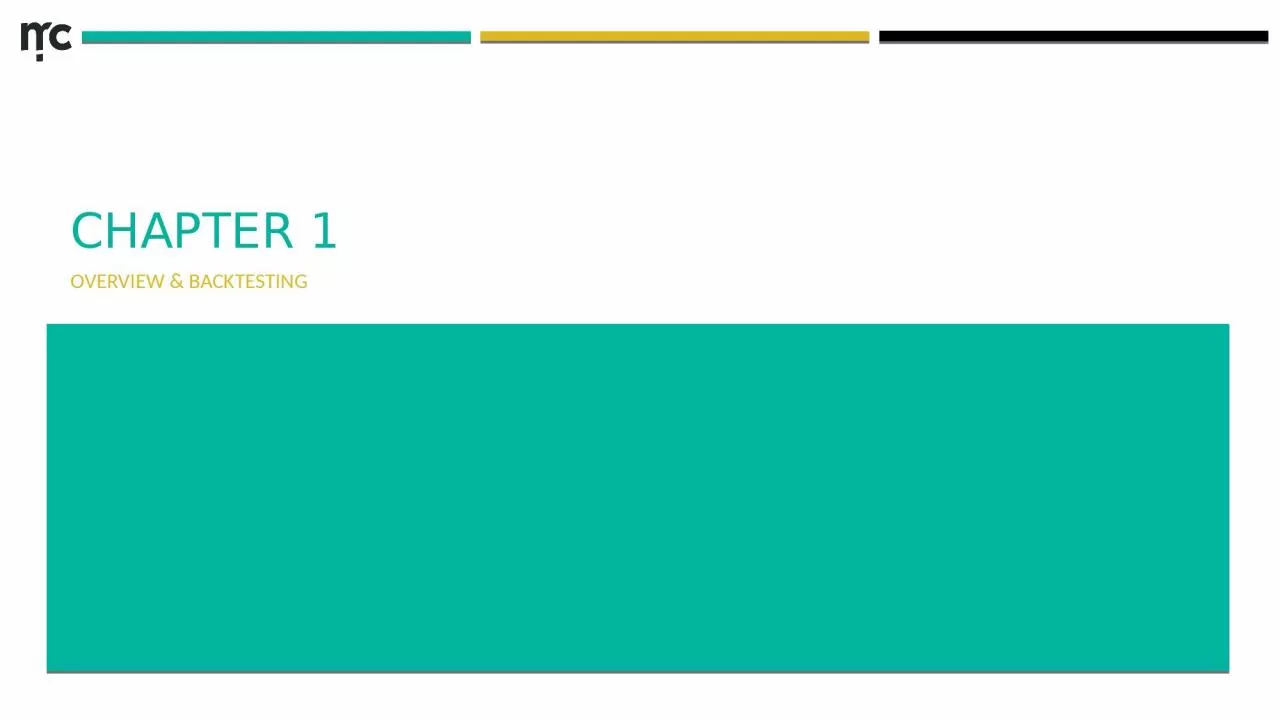

Overview There are two main strategies that will be covered in this book Mean Reversion Belief that an asset will revert back to an equilibrium point Drawn from interintraday data of stocks ETFs vs their components currency pairs futures calendarintermarket spreads ID: 1028934
Download Presentation The PPT/PDF document "Chapter 1 Overview & backtesting" is the property of its rightful owner. Permission is granted to download and print the materials on this web site for personal, non-commercial use only, and to display it on your personal computer provided you do not modify the materials and that you retain all copyright notices contained in the materials. By downloading content from our website, you accept the terms of this agreement.
1. Chapter 1Overview & backtesting
2. OverviewThere are two main strategies that will be covered in this book:Mean Reversion Belief that an asset will revert back to an equilibrium pointDrawn from inter/intraday data of stocks, ETFs vs. their components, currency pairs, futures calendar/intermarket spreadsBackwardation/contango with respect to futures contracts curvesMomentumBelief that an asset will continue its behavior4 main drivers of momentum in stocks and futuresStrategies based on news events, sentiment, leveraged ETFs, order flow, and HFT all will be covered in the book
3. Backtesting and automated executionBacktesting is done in hopes that the historical performance of a strategy will help us understand what to expect for future performanceThe profitability of a strategy (and therefore the effectiveness of a backtest) is extremely sensitive to changes in:Order TypeThe time that the order is placedUsing the bid/ask/last price to trigger a tradeThe author of a research paper cannot do out of sample testing within the research paper
4. Common pitfalls of backtestingAvoid at all costs
5. Look-ahead biasWhen your algorithm is using information in the future to determine today’s trading signalsExample: using the closing price of today to determine the entry signal for today’s tradesMitigate by using the same program for backtesting and live tradingCan’t make the same mistake live tradingMore common than you think!
6. Data snooping biasCaused by overfitting your model based on your training dataMay look great when testing but will likely look terrible with test data/OOS testingIf your model doesn’t quite meet your standards, DO NOT TWEAK IT to make it look betterEasiest way to avoid this is to use cross-validation (i.e. use different subsets of the data before using your training data/test data) Make the model as simple as possible, with as few parameters as possible, and with as few rules as possible
7. Stock splits and dividendsSome data sources may not account for stock splits and dividends in their price historyExample: look up the 1M chart of $OZM on Apple’s stock appUsually there is an option on Bloomberg for dividend/split adjustmentsYahoo finance also has dividend and split adjustments (and is free!)
8. Survivorship biasFailing to include delisted stocks means that your model will suffer from survivorship biasOnly including stocks that are trading today will give a false bias to your backtestFor example, taking the constituents of the TSX as they are today would mean ignoring all 29 stocks that were delisted in the past 4 monthsOr 39 for the TSXV
9. VenuesThe place in which stocks/futures/currencies are traded also affects your backtestStock data can be quoted using their primary exchange or using a consolidated datasetPrimary is more useful, prices can fluctuate more widely with the smaller orders that take place on other exchanges Currency markets are even more fragmented when compared to the stock market No requirement to trade at the best bid/ask across all venuesPrices and sizes are not generally available without a delay
10. Short sale constraintsShorting stock has a few drawbacksA broker first has to locate the shares you want to shortYou have to pay interest on the shares that you are shorting, and that can vary widely depending on short interest/difficulty of finding sharesSmall caps are more difficult to shortETFs are as hard to borrow as stocks“The $1.5 billion short bet against cannabis stocks is costing $2.4 million a day, or 200 times more than an equivalently sized bet against a basket of stocks including Apple, Amazon, IBM and Goldman Sachs, said Ihor Dusaniwsky, head of predictive analytics at S3 Partners.” Shorting Cannabis Stocks Is Getting Costly”https://www.nytimes.com/2018/09/17/business/dealbook/shorting-cannabis-stocks-costly.html
11. When not to backtest: example 1The SituationA backtest shows an annualized return of 30%The Sharpe ratio is 0.3The maximum drawdown duration is two yearsWhat’s wrong with it? High return, low Sharpe is indicative of a fluke strategyMaximum drawdown is way too long for any sort of investor to have any confidence in the strategy
12. When not to backtest: example 2The SituationA long only crude oil futures strategy returned 20% in 2007Sharpe ratio of 1.5What’s wrong with it? Simply holding the front month crude oil futures returned much more than 20% in 2007This strategy is worse than just buying and holdingAlways choose an appropriate benchmark
13. When not to backtest: example 3The SituationA simple “buy-low-sell-high” strategy picks the 10 lowest priced stocks at the beginning of the year and holds them for a year.The backtest return in 2001 is 388%What’s wrong with it? Returns are simply way too high to not be skepticalIf it seems too good to be true, chances are it isThis example had survivorship bias, and when accounting for delisted stocks, the strategy returned -100% in 2001
14. When not to backtest: example 4The SituationA neural net trading model that has about 100 nodes generates a backtest Sharpe ratio of 6What’s wrong with it? The words “neural nets” are red flags100 nodes means that there are at least 100 parameters in the modelSharpe ratio of 6 helps indicate that the model is overfitted
15. When not to backtest: example 5The SituationA high-frequency E-mini S&P 500 futures trading strategy has a backtest annual average return of 200 percent and a Sharpe ratio of 6. Its average holding period is 50 seconds.What’s wrong with it? Backtesting a high-frequency strategy doesn’t really make sensePlacing/executing an order can affect the market, especially in HFT